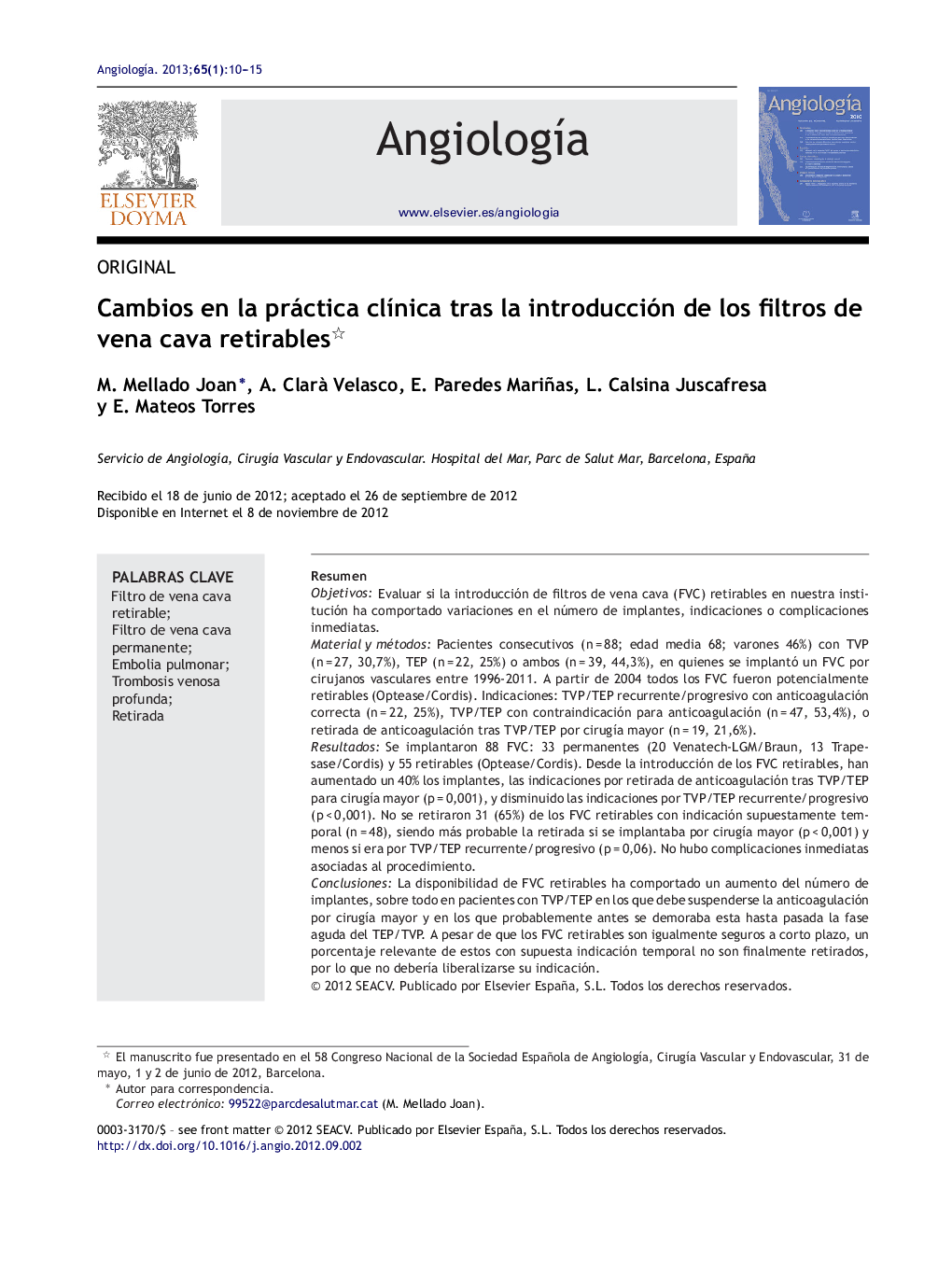| Article ID | Journal | Published Year | Pages | File Type |
|---|---|---|---|---|
| 2867613 | Angiología | 2013 | 6 Pages |
ResumenObjetivosEvaluar si la introducción de filtros de vena cava (FVC) retirables en nuestra institución ha comportado variaciones en el número de implantes, indicaciones o complicaciones inmediatas.Material y métodosPacientes consecutivos (n = 88; edad media 68; varones 46%) con TVP (n = 27, 30,7%), TEP (n = 22, 25%) o ambos (n = 39, 44,3%), en quienes se implantó un FVC por cirujanos vasculares entre 1996-2011. A partir de 2004 todos los FVC fueron potencialmente retirables (Optease/Cordis). Indicaciones: TVP/TEP recurrente/progresivo con anticoagulación correcta (n = 22, 25%), TVP/TEP con contraindicación para anticoagulación (n = 47, 53,4%), o retirada de anticoagulación tras TVP/TEP por cirugía mayor (n = 19, 21,6%).ResultadosSe implantaron 88 FVC: 33 permanentes (20 Venatech-LGM/Braun, 13 Trapesase/Cordis) y 55 retirables (Optease/Cordis). Desde la introducción de los FVC retirables, han aumentado un 40% los implantes, las indicaciones por retirada de anticoagulación tras TVP/TEP para cirugía mayor (p = 0,001), y disminuido las indicaciones por TVP/TEP recurrente/progresivo (p < 0,001). No se retiraron 31 (65%) de los FVC retirables con indicación supuestamente temporal (n = 48), siendo más probable la retirada si se implantaba por cirugía mayor (p < 0,001) y menos si era por TVP/TEP recurrente/progresivo (p = 0,06). No hubo complicaciones inmediatas asociadas al procedimiento.ConclusionesLa disponibilidad de FVC retirables ha comportado un aumento del número de implantes, sobre todo en pacientes con TVP/TEP en los que debe suspenderse la anticoagulación por cirugía mayor y en los que probablemente antes se demoraba esta hasta pasada la fase aguda del TEP/TVP. A pesar de que los FVC retirables son igualmente seguros a corto plazo, un porcentaje relevante de estos con supuesta indicación temporal no son finalmente retirados, por lo que no debería liberalizarse su indicación.
ObjectivesTo assess whether the introduction of removable inferior vena cava filters (VCF) has led to variations in the number of implants, indications, and immediate complications in our hospital.Materials and methodsThe study included consecutive patients (n = 88, mean age 68 years, males 46%) with DVT (n = 27, 30.7%), PE (n = 22, 25%) or both (n = 39, 44.3%) who had a VCF implanted by vascular surgeons between 1996-2011. Since 2004 all VCF were potentially removable (OptEase / Cordis). Indications DVT / PE recurrent / progressive with proper anticoagulation (n = 22, 25%), DVT / PE with contraindication to anticoagulation (n = 47, 53.4%), or removal of anticoagulation after DVT / PE for major surgery (n = 19, 21.6%).ResultsA total of 88 VCF were implanted: 33 permanent (20 Venatech-LGM/Braun, 13 Trapesase / Cordis), and 55 removable (OptEase / Cordis). Since the introduction of removable VCF, the number of implants increased by 40%, indications for anticoagulation after withdrawal of DVT / PE for major surgery increased (P = .001) and the indications for DVT / PE recurrent / progressive (P < .001) decreased. Thirty-one (65%) of supposedly temporary VCF (n = 48) were not removed. Removal was more likely if implanted in surgery (P < .001) and less if it was for DVT / PE recurrent / progressive (P < .06). There were no immediate complications associated with the procedure.ConclusionsThe availability of removable FVC has resulted in a higher number of implants, especially in patients with DVT / PE where anticoagulation should be discontinued for major surgery, and probably before that it was delayed until after the acute phase of PE / DVT. Although removable VCF are equally safe in the short term, a significant percentage of those with suspected temporary indications are eventually withdrawn, so its iindication should not be widened.
